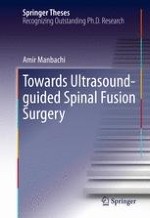2016 | Buch
Über dieses Buch
This thesis describes the design and fabrication of ultrasound probes for pedicle screw guidance. The author details the fabrication of a 2MHz radial array for a pedicle screw insertion eliminating the need for manual rotation of the transducer. He includes radial images obtained from successive groupings of array elements in various fluids. He also examines the manner in which it can affect ultrasound propagation.
Anzeige
